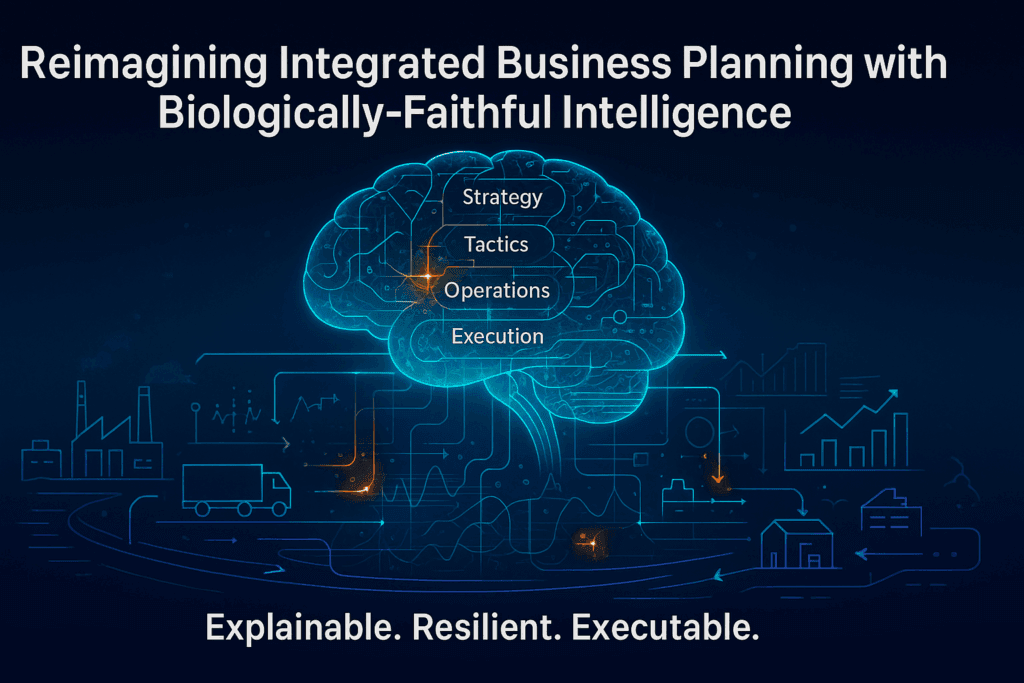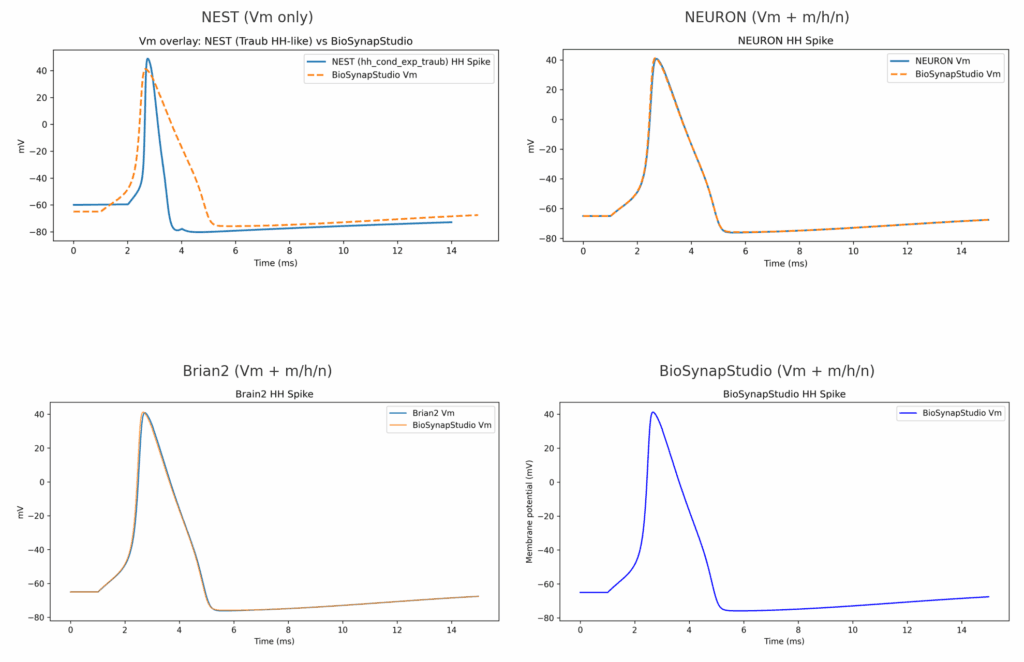Why IBP Matters Now …..
For many organisations, Integrated Business Planning (IBP) has become the backbone of aligning strategy, operations, and finance. In theory, IBP ensures everyone — from the boardroom to the shop floor — is working from a single, consistent plan. It should give executives confidence that decisions about growth, investment, supply, and customer service are grounded in reality.
But businesses today face a landscape unlike the one IBP was originally designed for. Supply chain shocks, geopolitical shifts, inflationary pressures, and demand volatility have become the norm, not the exception. In response, most IBP platforms have bolted on AI and machine learning modules to sharpen forecasts and optimise scenarios.
The challenge is that even with AI/ML, many of the old pain points remain. Forecasts still collapse under disruption, executives still question the “black box,” and operational teams still find gaps between the plan and reality.
This is where the opportunity lies: IBP needs more than faster statistics — it needs intelligence that is explainable, resilient, and executable.
The Limits of Today’s IBP (Even with AI/ML)
Most IBP platforms today rely heavily on AI/ML add-ons — demand forecasting engines, anomaly detection, and optimisation algorithms. These tools are powerful, but in practice they haven’t eliminated the core frustrations that businesses face:
- The Trust Gap
Machine-learning models may produce accurate curves, but they rarely explain themselves. At the board level, when millions in capital allocation are at stake, a “just trust the algorithm” answer doesn’t cut it. Executives demand transparency and causality, not correlations hidden in a black box. - Fragility Under Disruption
AI/ML thrives on historical patterns — but when a disruption hits (a pandemic, a supplier collapse, a demand surge), history is no guide. Models trained on yesterday fail to adapt to tomorrow. Businesses are left scrambling to re-train or override the system manually. - The Execution Drift
Plans often look convincing in dashboards but fall apart at the operational level. Forecasts and optimisations may suggest one path, but real-world constraints — capacity, lead times, bottlenecks, shelf-life limits — are not faithfully represented. This creates the familiar gap between “the plan” and “what actually happens.”
These shortcomings are not trivial. They erode confidence in IBP processes, slow decision-making, and ultimately limit the value of the platforms themselves. AI has improved speed and pattern recognition, but it hasn’t solved IBP’s most persistent weaknesses.
Where Equation-Based Intelligence Has Been Tried
Before AI/ML became the default solution for forecasting and optimisation, businesses often turned to equation-based approaches to bring rigour into planning. These methods are still widely used — and they hint at what’s possible when decision-making is grounded in transparent models.
- System Dynamics
Popularised by Jay Forrester, system dynamics uses differential equations to model stocks, flows, and feedback loops. In IBP, it has been applied to simulate supply chain effects such as the bullwhip effect. While valuable for big-picture insights, it tends to be too aggregate for daily planning decisions. - Operations Research & Optimisation
Linear programming, mixed-integer optimisation, and stochastic modelling remain staples of supply chain planning. They excel at solving specific allocation and scheduling problems, but they require precise formulations and often break down in noisy, disrupted environments. - Model Predictive Control (MPC)
Borrowed from control engineering, MPC recalculates optimal decisions over a rolling horizon, based on mathematical models of the system. It has been used in production scheduling and capacity planning. But MPC assumes relatively stable systems and can become computationally heavy when scaled to complex, global supply networks. - Digital Twins & Simulation
Digital twin technologies replicate processes through physics-based models and simulation. They provide rich scenario analysis and are useful for stress testing. However, they are often siloed, operational tools that don’t integrate seamlessly with financial or strategic planning.
These approaches all share one strength: explainability. They are rooted in equations that executives and planners can interrogate. But they also share a weakness: rigidity. Most cannot adapt gracefully to the uncertainty, noise, and volatility that define today’s business environment.
This is the gap Qognetix was built to fill.
Enter Qognetix: An Intelligence Substrate for IBP
Qognetix takes the strengths of equation-based intelligence — causality, explainability, and auditability — and combines them with adaptive dynamics inspired by biology. Instead of choosing between rigid equations or opaque machine learning, it provides a biophysically-faithful substrate that learns continuously while staying transparent.
At its core, the Qognetix engine is a deterministic, state-based system. It models demand, supply, capacity, and financial flows through causal mechanisms rather than statistical curve-fitting. Every recommendation can be traced back to parameters like lead time, throughput, or demand variability — the same levers planners already understand.
Where it differs from traditional modelling is in its ability to calibrate live. The system adapts to noise, shocks, and changing environments the way biological systems do — updating parameters incrementally instead of retraining from scratch. This makes it inherently more resilient than AI/ML models that depend on clean historical data.
For IBP, this means:
- Explainability: Executives can trust the scenarios they see, because the reasoning is causal, not a hidden correlation.
- Resilience: Tactical and operational plans adapt continuously, even when disruptions hit.
- Executability: Plans respect physical and financial constraints, keeping strategy and operations aligned.
Qognetix is not another IBP platform. It is the intelligence layer that can sit inside existing IBP workflows — enhancing them with a level of trust, adaptability, and realism that today’s AI-enhanced systems can’t deliver.
Decision-Making Layers Where It Adds Value
Integrated Business Planning is designed to connect every layer of decision-making in an organisation. Yet each layer has different priorities, timescales, and pain points. Qognetix enhances IBP by providing intelligence that works consistently across all four layers:
1. Strategic Layer (Board & C-Suite)
- Horizon: 3–5 years.
- Focus: Market entry, long-term investments, sustainability commitments, capital allocation.
- Challenge: Board members hesitate to base decisions on opaque models.
- With Qognetix: Scenarios are grounded in causal mechanisms, not black-box statistics. Strategic choices can be justified with transparent assumptions and verifiable audit trails.
2. Tactical Layer (Business Units & Functional Leaders)
- Horizon: 12–18 months.
- Focus: Portfolio mix, capacity expansions, promotional strategies, resource allocation.
- Challenge: Plans become rigid, and adjustments are slow when conditions change.
- With Qognetix: Adaptive dynamics enable fast re-planning under volatility. Trade-offs between capacity, service levels, and margins emerge naturally, giving leaders agility without guesswork.
3. Operational Layer (Planners & Controllers)
- Horizon: Weeks to quarters.
- Focus: Forecast accuracy, inventory policies, production schedules.
- Challenge: Noise, data gaps, and anomalies force constant firefighting.
- With Qognetix: Mechanistic forecasting tolerates noise gracefully. Anomalies are detected early, and recommendations are explainable, so planners understand why a decision is being suggested.
4. Execution Layer (Day-to-Day Operations)
- Horizon: Daily.
- Focus: Order fulfilment, logistics, customer commitments.
- Challenge: The gap between “the plan” and what execution teams can realistically deliver.
- With Qognetix: Constraints such as lead times, bottlenecks, and capacity limits are built in, so tactical and strategic plans remain feasible. Execution teams see fewer surprises, and delivery aligns with promises.
In short, Qognetix strengthens IBP at every level — from the boardroom to the warehouse floor — by ensuring that decisions are trustworthy, adaptive, and executable.
Opportunities for IBP Vendors and Practitioners
The IBP market is already crowded with platforms that promise alignment, forecasting, and scenario modelling. Yet because many of them lean heavily on AI/ML or rigid optimisation, they struggle to differentiate in ways that matter to executives. This creates clear opportunities for vendors, consultants, and practitioners who integrate intelligence like Qognetix into their offerings.
1. Differentiation in a crowded field
Most IBP tools talk about AI, but few can offer explainability and resilience in the same breath. By embedding mechanistic, adaptive intelligence, vendors can set themselves apart as the “trustworthy IBP” platform — board-ready and disruption-proof.
2. Winning executive trust
Executives are often the blockers in IBP adoption, sceptical of forecasts they can’t interrogate. With Qognetix, scenarios become transparent and auditable. That credibility can unlock faster buy-in and broader adoption.
3. Resilience under disruption
Clients are demanding proof that their IBP systems can handle shocks — from supply disruptions to demand volatility. Traditional AI stumbles here; an IBP platform powered by Qognetix demonstrates resilience without endless retraining cycles.
4. Efficiency and cost advantage
Large AI models require constant retraining, data pipelines, and cloud compute. Qognetix operates with deterministic solvers and bounded precision, making it leaner and more cost-effective — a practical advantage for vendors and clients alike.
5. Future-proof positioning
With a roadmap that extends to sovereign, hardware-accelerated deployment (e.g. appliance or SIPU-based models), IBP vendors can reassure clients that they’re not just investing in today’s toolset, but in an architecture designed to endure.
For practitioners, the opportunity is equally strong: embedding Qognetix intelligence into consulting workflows or custom IBP projects creates a tangible performance edge. It means they can promise not just aligned plans, but plans that work in the real world.
Pathways to Collaboration
For IBP vendors and practitioners, the question is less whether to integrate next-generation intelligence, and more how. Qognetix can slot into IBP ecosystems in multiple ways, each tailored to a partner’s maturity, client base, and growth strategy.
1. OEM / Licensing (“Powered by Qognetix”)
Vendors can embed Qognetix directly into their IBP platforms as an intelligence engine, without exposing the underlying IP. This model allows them to differentiate in the market while Qognetix remains the invisible substrate under the hood.
2. Consulting-to-Software Pilots
Consultants can use Qognetix within their client engagements to prove performance gains — improved forecast accuracy, higher service levels, reduced inventory. These case studies can then evolve into repeatable software offerings. It’s a low-risk way to commercialise both methodology and technology together.
3. Joint Development of Vertical Solutions
Certain industries — pharmaceuticals, aerospace, fast-moving consumer goods — face planning challenges that generic IBP platforms struggle with. By co-developing verticalised solutions, partners can bring “ready-to-run” packages to market that blend domain expertise with adaptive intelligence.
4. Funding and Regional Opportunities
In regions like Ireland and the EU, joint ventures around IBP innovation can tap into Enterprise Ireland’s High Potential Start-Up (HPSU) programme or Horizon Europe funding. By pairing Qognetix’s technology with a partner’s domain credibility, these opportunities become much more accessible.
5. Appliance and Sovereign Deployments
For defence, aerospace, and other critical sectors, Qognetix can be delivered as a sealed appliance, ensuring both data sovereignty for the client and IP protection for the vendor. This opens up high-value markets where cloud SaaS alone cannot reach.
Each pathway balances IP protection with commercial opportunity. Whether through licensing, co-development, or consulting pilots, the goal is the same: make IBP systems more trustworthy, resilient, and executable by embedding a new class of intelligence.
Closing Call
IBP has always been about alignment — getting strategy, operations, and finance on the same page. But alignment alone is no longer enough. In today’s environment of constant disruption, businesses need intelligence that can be trusted in the boardroom, adapt in the face of shocks, and deliver at the point of execution.
AI and machine learning have improved the speed and scope of planning, but they haven’t solved its deepest weaknesses: the trust gap, fragility under disruption, and the drift between plan and reality.
Qognetix offers a new way forward. By embedding biologically-faithful, equation-based intelligence into IBP systems, we enable plans that are explainable, resilient, and executable. It’s not about replacing existing platforms — it’s about elevating them.
For IBP vendors, this is an opportunity to differentiate in a crowded market, win executive trust, and future-proof their platforms. For consultants and practitioners, it’s a chance to deliver measurable performance gains and turn methodology into software value. And for enterprises, it’s the promise of planning systems that finally keep pace with the real world.
The next generation of IBP won’t just align departments. With the right intelligence layer, it will integrate with the dynamics of reality itself.



